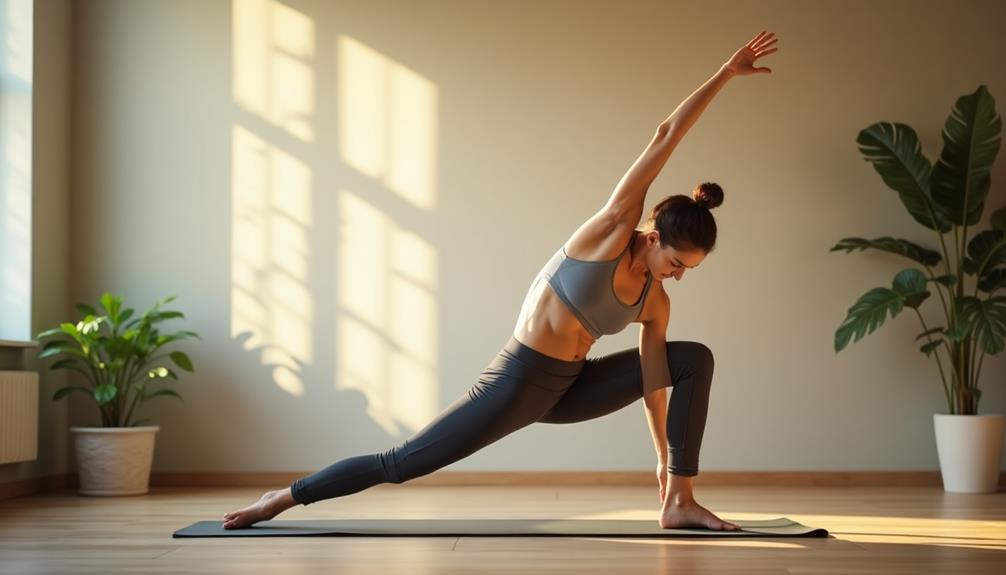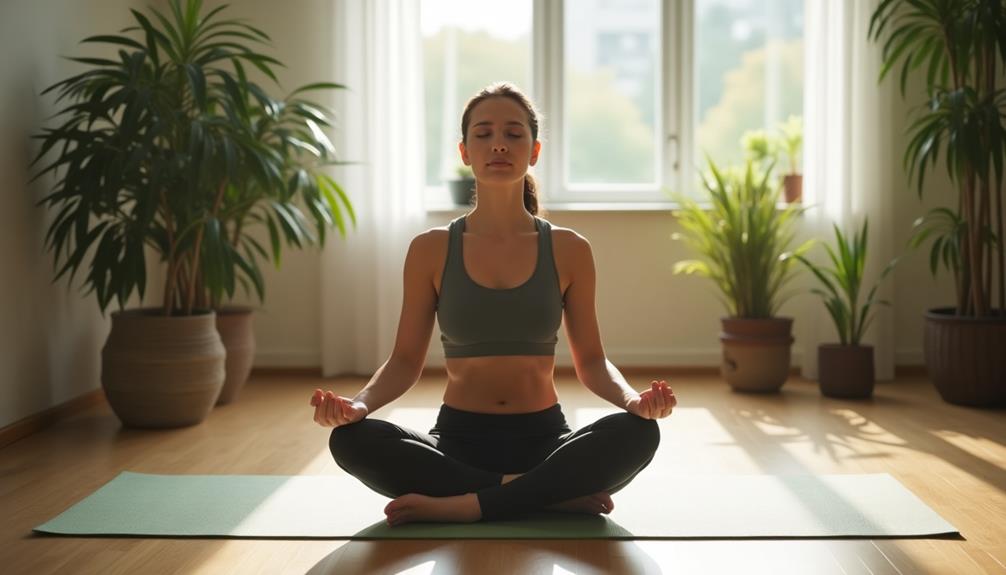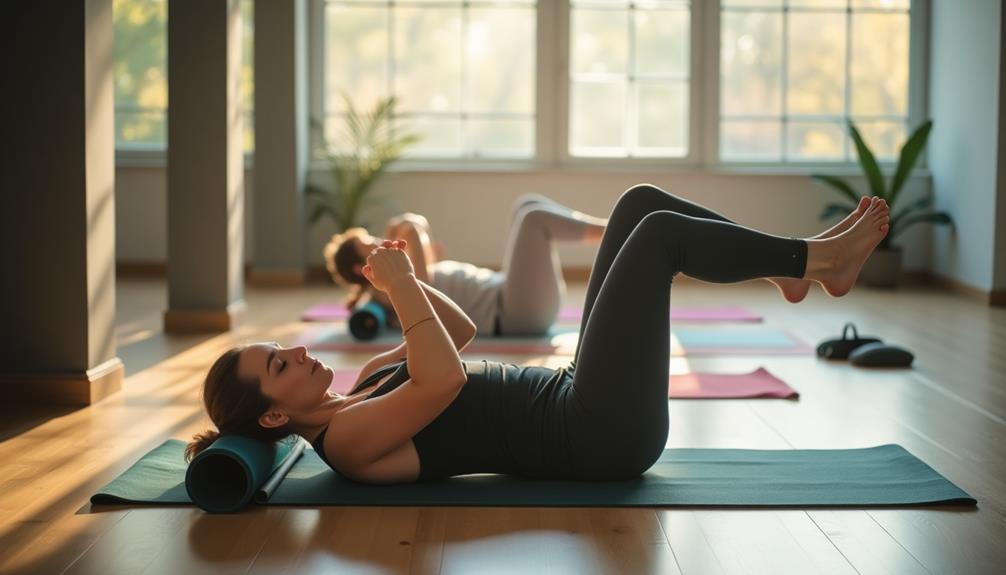Cooling down after your workout is essential for recovery. Start with static stretches, holding each for 15-30 seconds, focusing on major muscle groups. Incorporate breathing exercises, like diaphragmatic or box breathing, to help relax your body. Hydration is critical; drink water or electrolyte-rich beverages to replenish lost fluids. Consider foam rolling to release tension and improve blood flow, targeting tight areas. This routine helps lower heart rate gradually, minimizes soreness, and restores flexibility. By following these steps, you'll support your body's recovery effectively. There's even more you can explore to enhance your post-workout routine.
Core Insights
- Gradually reduce intensity with light aerobic activity for 5-10 minutes to help normalize heart rate and breathing.
- Perform static stretches for major muscle groups, holding each for 15-30 seconds to enhance flexibility and reduce tension.
- Incorporate foam rolling to release muscle tightness and improve blood circulation, focusing on affected areas for 20-30 seconds.
- Practice breathing exercises, such as diaphragmatic or box breathing, to promote relaxation and mental clarity post-workout.
- Rehydrate with water or electrolyte-rich beverages immediately after your workout to replenish lost fluids and minerals.
Importance of Cooling Down

Cooling down after a workout is essential, as it helps your body shift back to its resting state. This process allows your heart rate and breathing to gradually return to normal, reducing the risk of dizziness or fainting. By slowing down your activity, you also promote better circulation, which helps remove lactic acid and other waste products from your muscles. This can minimize soreness and stiffness later on. Incorporating electrolyte gummies into your post-workout routine can further support hydration and replenish essential minerals lost during exercise, enhancing your overall recovery process.
Additionally, cooling down can aid in mental recovery. It provides you with a moment to reflect on your workout, promoting mindfulness and self-awareness. Incorporating a proper cooldown routine into your regimen not only enhances your physical recovery but also helps you establish a consistent workout practice, setting a solid foundation for future training sessions.
Effective Stretching Techniques

After your workout, incorporating effective stretching techniques can further enhance your recovery. Start with static stretches, holding each position for 15 to 30 seconds. Focus on major muscle groups like hamstrings, quadriceps, and shoulders. This helps improve flexibility and reduce muscle tightness. For a more intense stretch, consider using a high-density foam roller to target specific muscle groups and promote myofascial release. These tools can be particularly effective for hard-to-reach areas and enhancing overall flexibility.
Next, try dynamic stretches, such as arm circles or leg swings. These can increase blood flow and prepare your muscles for movement.
Don't forget to include stretches targeting specific areas where you feel tightness. For example, if you've worked your back, consider a gentle spine twist.
Breathing Exercises for Recovery

Incorporating breathing exercises into your post-workout routine can greatly enhance your recovery. These exercises help reduce heart rate and promote relaxation, allowing your body to shift from an active state to a restful one.
Here are a few effective breathing techniques:
| Technique | Description |
|---|---|
| Diaphragmatic | Breathe deeply through your nose, expanding your abdomen. Exhale slowly through your mouth. |
| Box Breathing | Inhale for 4 counts, hold for 4, exhale for 4, then hold for 4. Repeat. |
| 4-7-8 Breathing | Inhale for 4 counts, hold for 7, exhale for 8. Focus on relaxation. |
| Alternate Nostril | Close one nostril, inhale through the other, switch, and exhale. This balances energy. |
These techniques not only aid recovery but also promote mental clarity. Incorporate them regularly for best outcomes.
Hydration Post-Workout

Proper hydration is essential for your recovery after a workout. When you exercise, you lose fluids through sweat, and it's pivotal to replenish them to support your body's healing processes. Drinking water or electrolyte-rich beverages can help you recover more effectively. Hydration powders can be an excellent option for replenishing electrolytes and maintaining proper mineral balance post-workout. These powders often come in various flavors and offer convenience for on-the-go hydration. Here are some tips to keep in mind:
- Drink water immediately after finishing your workout to start rehydrating.
- Consider electrolyte drinks if your session was particularly intense or long.
- Monitor your urine color; a light yellow indicates proper hydration.
Incorporating Foam Rolling

Foam rolling can be a game-changer for your post-workout recovery routine. By targeting tight muscles and fascia, it helps release tension and improve blood flow. Start by selecting a foam roller that suits your needs—whether it's a high-density option or a softer one.
Begin rolling on your major muscle groups, like your quads, hamstrings, and back. Spend about 1-2 minutes on each area, using slow, controlled movements. If you find a particularly tight spot, pause and apply gentle pressure for 20-30 seconds.
Incorporating foam rolling into your cooldown can enhance flexibility and reduce soreness. Aim to roll at least two to three times a week for [BEST] results. Your body will thank you for it!
Frequently Asked Questions
How Long Should a Cool-Down Session Last After Workouts?
Cooling down is essential, so don't cut corners. Ideally, you should spend about 5 to 10 minutes after workouts. It helps your body shift, preventing stiffness and soreness. You'll feel the difference later, trust me!
Can Cooling Down Prevent Muscle Soreness?
Cooling down can help reduce muscle soreness by gradually lowering your heart rate and improving circulation. It promotes recovery and flexibility, making your post-workout experience more comfortable. You'll feel better prepared for your next session.
Is It Necessary to Cool Down After Light Exercise?
You might think of cooling down as a gentle hug for your muscles after light exercise. While it isn't strictly necessary, taking a moment to ease your body back can enhance recovery and prevent future discomfort.
What Are the Signs of an Ineffective Cool-Down?
If your heart rate remains elevated, you feel dizzy or lightheaded, and your muscles are excessively sore the next day, you're likely experiencing an ineffective cool-down. You need to adjust your recovery routine to improve.
Should I Cool Down Differently for Different Types of Workouts?
Yes, you should cool down differently based on your workout type. For intense cardio, focus on gradually lowering your heart rate. For strength training, emphasize stretching the muscles worked to enhance recovery and flexibility.

